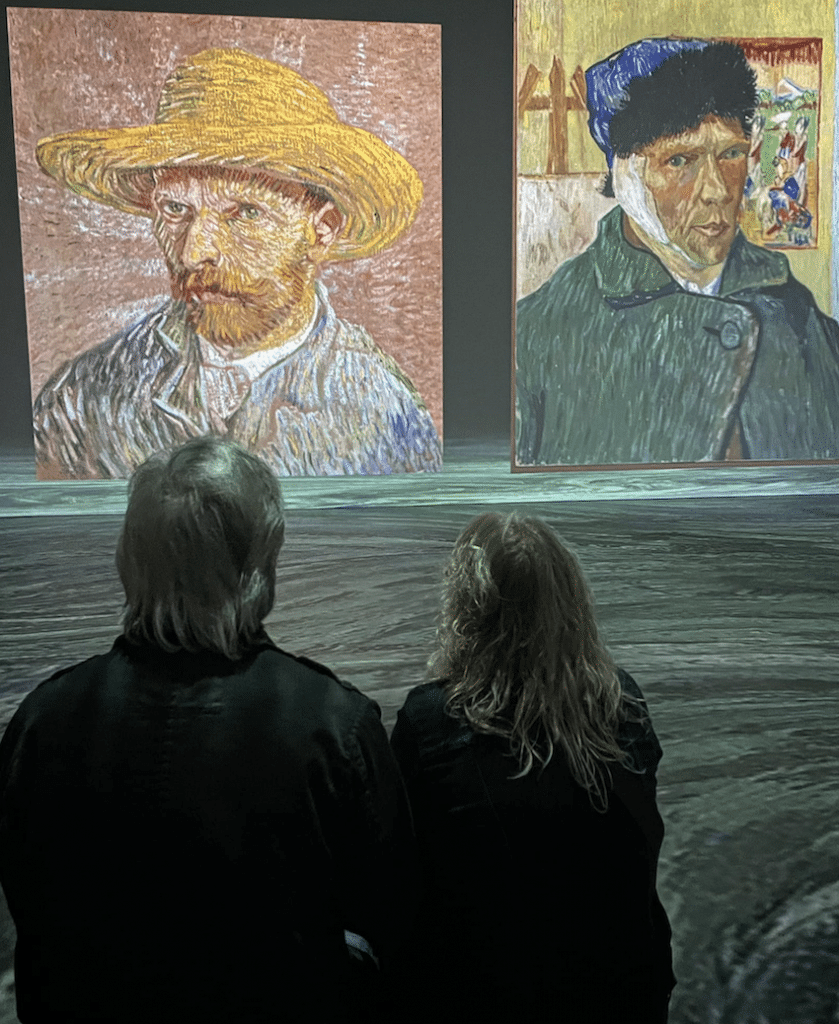
Milwaukee was among the first American cities to experience an Immersive Van Gogh exhibition.
By Jacqueline Swartz
Back in 2020, a pandemic swept over much of the globe. People turned inward and went out sparingly to places where they could be with others, yet physically distanced.
No, not Covid. The epidemic this story documents is that of immersive art exhibits that today are moving digital projections of masterpieces into urban spaces for the enjoyment of people who would never even think of going to a museum.
North American cities are preparing exhibits featuring 19th-century artist Gustav Klimt and Mexican icon Frida Kahlo. Similar shows on Paul Cezanne and Russian Wassily Kandinsky will soon appear in France. The presentations combine moody sounds with subtle lighting and digital images that slowly creep around walls and over ceilings and floors. People stand raptly, almost transfixed, immersed in flowing art that seemingly has escaped the museum so it can play with the public’s imagination.
It all began with Vincent van Gogh. In the summer of 2020, his tortured self-portrait began appearing on telephone poles and bus stops around Toronto. They promoted a new kind of art exhibit: “Immersive Van Gogh,” a sound, light and musical experience of the tormented Dutch painter’s work.
Those who bought tickets to “Immersive van Gogh” saw over 400 moving images projected on the walls and floors of a cavernous newspaper printing plant. There were yellow sunflowers and blue irises, mauve olive groves, each morphing into another painting. You could see the artist’s thick, intense brush strokes. It was a trippy way of experiencing art while observing social distancing.
Constantly drifting paintings break apart only to merge back together. In The Potato Eaters (1885), a dark portrayal of poor farmers, portraits of impoverished people emerge individually before assembling around the table in van Gogh’s painting. The windmill blades of Le Moulin de Galette (1886) move, while the rest of the painting is still. The white flowers of Almond Blossom (1886) float through the air and land on the dark branches set against a blue sky.
Art Challenges Movies, Concerts
“It never would have happened without the pandemic,” Svetlana Dvoretsky told the Toronto Star. She is a founding partner of Lighthouse Immersive the company that first opened van Gogh exhibits in North America. By the end of 2021, the company had opened exhibits in 21 cities including New York, Chicago, Houston, Los Angeles and San Francisco, selling over four million tickets. According to Ticket Master, it’s the largest selling entertainment attraction in North America. Lighthouse Immersive’s website claims the Immersive van Gogh exhibit “quickly became the #1 selling show in the world.”
The huge projections and animation really do immerse viewers. They also control what they see. There’s no pause button. But unlike watching a film, you can choose another image to look at by turning to another wall or a floor. The whole show is on a loop that takes from 35 to 60 minutes, depending on the city where it’s shown. If you want to see an image for a longer time, you have to wait for the next go-around.
The music for the Lighthouse Immersive shows, curated by Luca Longobardi, adds to the drama. At one point, Edith Piaff’s anthem of emotional survival, “Non, je ne regrette rien,” blasts out. Some might wonder what it has to do with the suicidal genius, Van Gogh, while to others it adds an operatic note to the spectacle.

Later this month the Atelier des Lumières in Paris next will open an immersive showcase featuring Vassily Kandinsky’s “Odyssey of the Abstract.” A Russian painter born in Moscow in 1866, Kandinsky is credited as being one of the pioneers of abstraction in western art. Unlike North America’s immersive exhibits, which last as long as there are customers, this one, as well as the Cezanne show, will run from Feb 18 to Jan 23, 2023. Photo courtesy of Culturespaces
Multiple Van Gogh shows
Before Toronto there was France. In 2001, an exhibit now called Imagine van Gogh, transformed an underground quarry in the South of France into an immersive venue called Cathedrale d’Images. The spectacle was presented in 2011 at the Art Scene Museum in Singapore, and in 2017 an upgraded version began running in Paris
Then came another van Gogh show, this one at the Paris digital art center, Atelier des Lumieres. As it turned out, the immersive exhibit reached an unexpected audience – viewers who watched the 2020 hit Netflix show, Emily in Paris, the most popular original comedy on Netflix in 2020. They were wowed when, in one scene, they saw the American ingenue gazing at projections of van Gogh’s “The Starry Night” on walls and floors. (Immersive shows of Paul Cezanne and Vassily Kandinsky will begin on Feb 18).
The Paris exhibit was designed by Italian video artist Massimilano Siccardi, who subsequently was hired by Lighthouse Immersive to produce the much more sophisticated immersive van Gogh experience.
“Siccardi wanted to create a show that allows people to imagine the artist’s state of mind and vision,” says Lighthouse Immersive creative consultant Richard Ouzounian, a theatre director and former entertainment writer for The Toronto Star. “He wanted to create another work of art.”
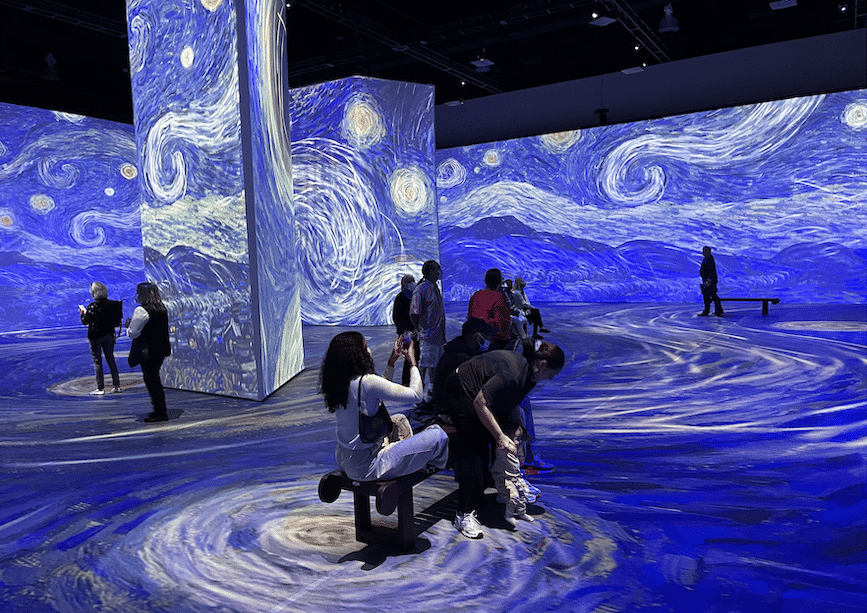
The Starry Night was painted in 1889, from a room in the mental asylum at St. Remy de Provence. During his one-year stay, Vincent van Gogh painted 150 paintings there. This one draws the viewer in with swirling shapes and intense colors. The original painting has been displayed at New York’s Museum of Modern Art since 1941.
Can an immersive show really illuminate Van Gogh’s state of mind? Or reveal what he was thinking when he painted Starry Night, shortly after checking himself into the asylum in Saint-Remy de Provence in order to prevent violence to himself and others? We can’t know for sure, but we are getting a heady vision, one that goes beyond projecting pretty pictures onto huge spaces.
Why are people so drawn to van Gogh’s work? According to the late art critic and Booker prize-winning novelist, John Berger, much of the enduring popularity of Van Gogh has to do with his down-to-earth respect for everyday things. “For him, the act of drawing or painting was a way of discovering and demonstrating why he loved so intensely what he was looking at, and what he looked at during the eight years of his life as a painter belonged to everyday life.”
Van Gogh Everywhere
There are now 40 immersive van Gogh exhibitions in North America. The Lighthouse Immersive show, which now bills itself as the original, has mounted more than half of them, but there are several other companies as well. Some are showing their van Gogh exhibits at the same time. In Los Vegas, Van Gogh: The Immersive Experience, which is showing in various US cities and in Berlin, Germany and London., co-exists with Beyond van Gogh.
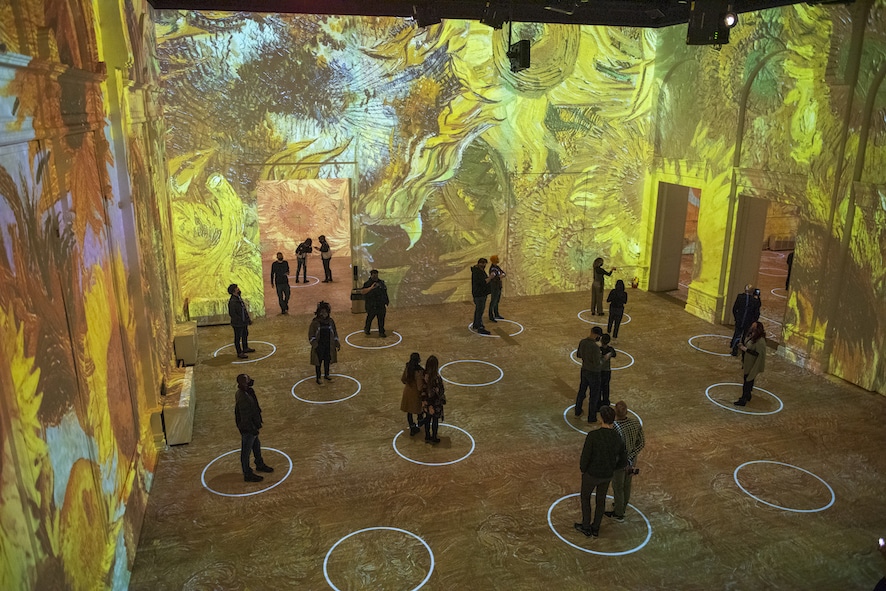
Immersive Van Gogh presentations like this one in Chicago create an artistic dreamscape where viewers can wander into other rooms through open doors without interrupting the immersive experience. Photo Credit Michael Brosilow
Another show, Imagine Van Gogh, created by the company that originated the Van Gogh exhibit in France in 2008 is opening in Buenos Aires in 2022. It calls itself the original and says on its website, “No add-on, no antics. The creators respect all of the original artwork.”
The statement points to some of the differences in how the spectacles are presented. In Beyond van Gogh, now showing in Las Vegas, Charleston and other US cities and opening in Chile and Puerto Rico, some projections of paintings remain longer before dissolving into other paintings. You can return to Bedroom in Arles, with its yellowish roughhewn furniture and blue walls, after turning to another wall and being engulfed in swirling flowers, cafes and landscapes. But you don’t get the kind of dizzying animation and dramatic vision of the Lighthouse Immersive shows.
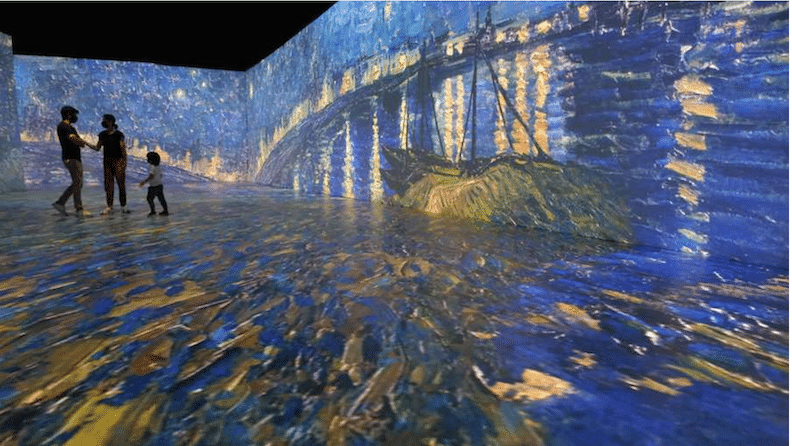
Immersive art exhibits are a good place to take children. They have a kind of enchanting fairy tale feel. And the duration of the exhibit – from 30 to 60 minutes – also works for those with limited attention spans.
Erotic Klimt
In a room adjacent to the Toronto Van Gogh show is another Lighthouse Immersive production that will soon open in other North American cities. Immersive Klimt, which soon will open throughout North America, presents the Viennese artist’s dazzling colors and fluid, often erotic imagery. It’s a natural for the audio-visual pizazz of an immersive spectacle.
The life of Gustav Klimt (1862-1918) couldn’t be more different from that of Van Gogh. From Klimt’s early awards and his academic training to the many women he slept with during the golden age of Vienna, he was a man in charge — even when he shocked conservative authorities with his fluid forms and paintings of women in various states of pleasure.
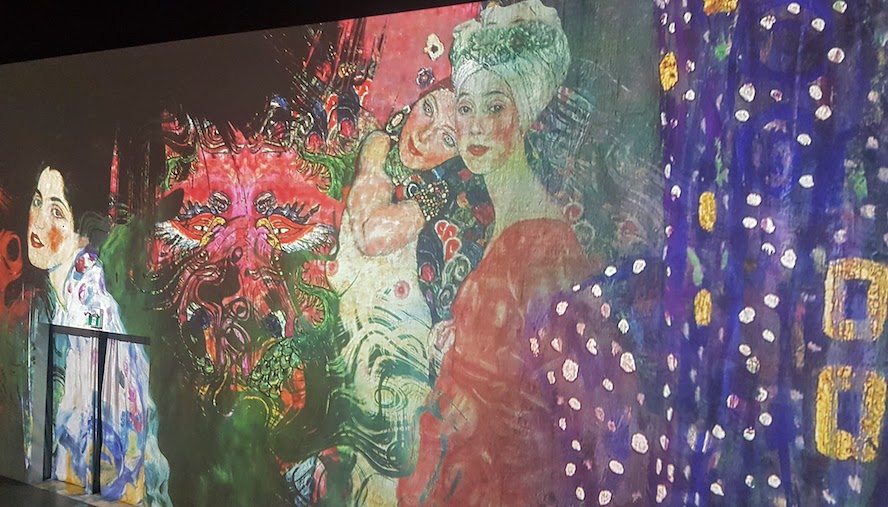
Austrian painter Gustav Klimt painted women in various states of yearning and dress. Immersive presentations featuring this painting called “Friends” always include “Woman in Gold,” “The Kiss” and “Danae.” The swirling images make for an erotic journey. Photo by Jacqueline Swartz
Immersive Klimt begins with the classical influence of the painter’s early years when he created murals and architectural detail for the late 1800s buildings that were popping up in Vienna thanks to Emperor Franz Joseph’s grand plan. Paintings of opulent concert halls enhanced by a soundtrack of Strauss waltzes give way to Art Nouveau paintings with swirling lines and jewel-tone colors. As the paintings become less formal and more erotic, the music follows the melancholic strains of composer Gustav Mahler. He was a contemporary of Klimt, as was Sigmund Freud.
One of the most recognizable images in the show is Woman in Gold, the portrait of Adele Bloch-Bauer, embedded in a golden background of Byzantine tiles. The other one, of course, is The Kiss, recognizable from endless posters.
Immersive Art’s Surreal World
Immersive spectacles seem here to stay. The Lighthouse Immersive company plans to produce a new show every few months, with the Mexican artist, Frida Kahlo next on the list. Other companies are getting in on the action worldwide, from Beijing to Buenos Aires. But they are far from identical. One company is offering a spectacle in a box, saying it can be purchased and easily set up. Another in London spoofed Van Gogh’s famous Bedroom in Arles painting with a real bed on which customers could lie down and take selfies.
“No, you cannot put your head through a cutout of The Kiss and have someone kissing you,” quips Richard Ouzounian, referring to what you won’t find at Lighthouse Immersive shows.
Will this phenomenon, so in-synch with our multi-screen, streaming times, put museums out of business? It’s the wrong question. The immersive multi-media trip is not the same as the more contemplative museum experience. There’s room for both. And an immersive art experience might even lead viewers to museums.
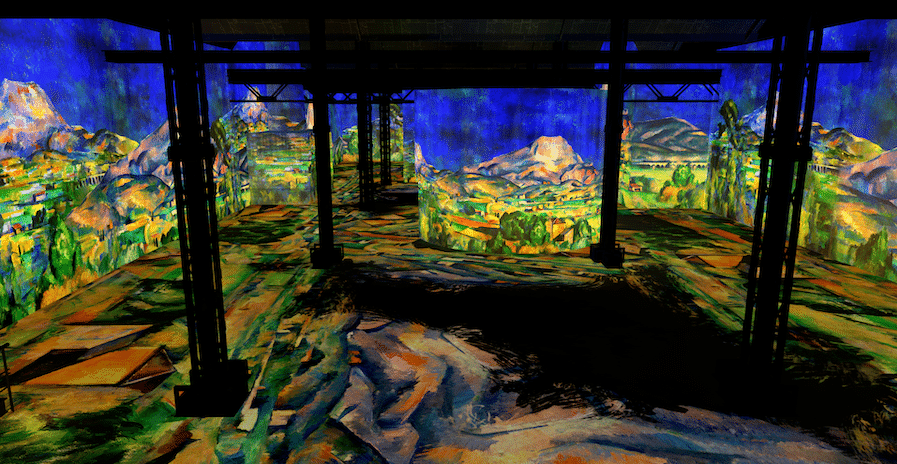
Paul Cezanne (1839-1906) painted still life, people and particularly nature, which eventually became his great theme. He painted Mont-St-Victoire many times – its colors, shapes and moods are his signature. At the Atelier des Lumieres in Paris, “Cezanne, the lights of Provence” will run through 2022. Cezanne took impressionism to cubism and is credited as being a pioneer of modernism. A native of Aix-en-Provence, he was self-taught and produced 900 canvases and 400 watercolors.
Museums are not canceling their van Gogh exhibits. Detroit is an example: An Immersive van Gogh show opens there in February 2022, and in October, the Detroit Institute of the Arts will feature dozens of works by the artist.
It’s true that museums are not seeing the millions of dollars in ticket sales that are pouring into immersive shows, but it’s hard to compare the profits of the two during the Covid shutdown, which closed museums but not immersive exhibits.
From Immersive Art to Alternative Reality?
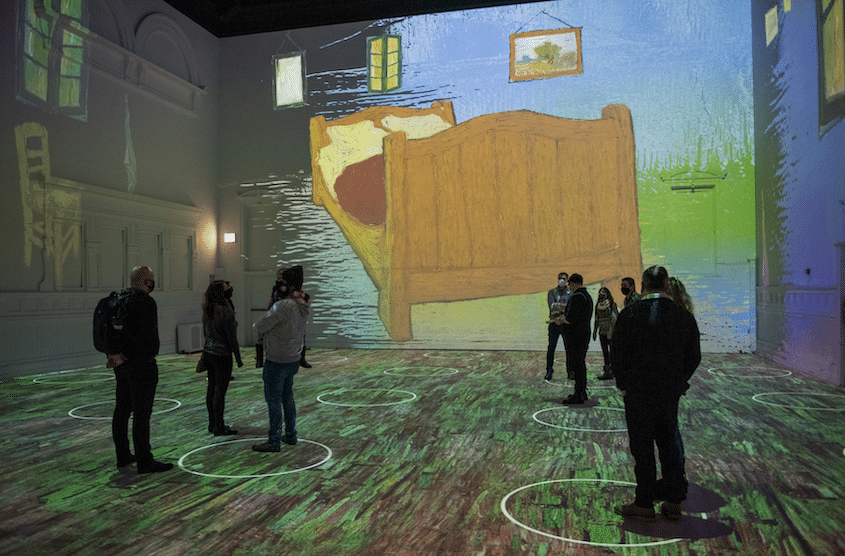
“Immersive Van Gogh” event in Chicago offered a surreal melding of light and proportion. Photo by Michael Brosilow
As reproductions proliferate, people are realizing the value of the real thing. Van Gogh’s paintings fetch some of the highest prices in the art world. Klimt’s portrait of Adele Bloch-Bauer, The Woman in Gold, sold for $160 million at auction.
Who knows what’s next. In October 2021, Hong Kong hosted the first-ever Digital Art Fair, with a section called The Immersive Zone.
One subject that seems perfect for immersive exhibits is nature. Want to go up the Amazon River before it disappears? No such show has been mounted yet, but it’s easy to imagine. Shanghai, Melbourne and Sharjah in the United Arab Emirates all offered “Rain Room” immersive experiences, where a sensor stops the rain when a person walks by.
In Tokyo’s digital art museum, the Team Lab Borderless exhibit allows visitors to move around in three-dimensional spaces and connect with artworks that glide freely in and out of the rooms. One zone shows a forest of lamps; another a computer-generated forest where you can touch digital birds.
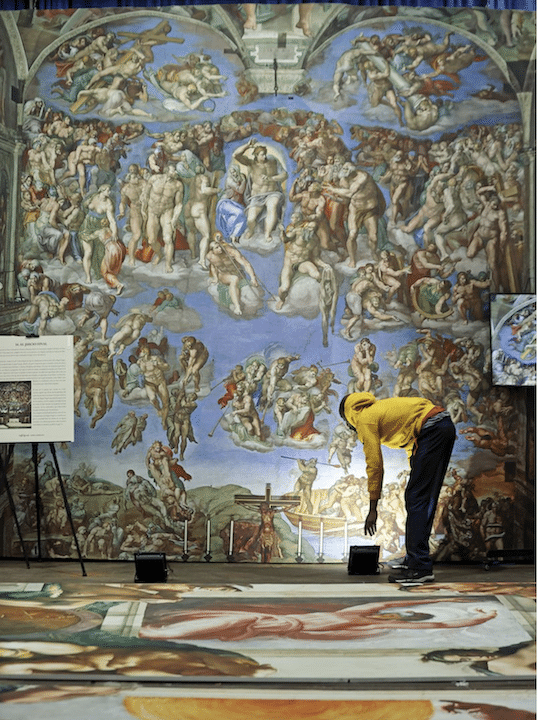
The Great Lakes Mall on the outskirts of Cleveland is not known for fine art. But starting next week shoppers can walk inside an empty auto garage converted into Michelangelo’s Sistine Chapel. Immersive art experiences allow families with children to experience masterworks they might otherwise never have a chance to see. Photo by Joshua Gunter, cleveland.com
At the Great Lakes Mall on the outskirts of Cleveland, OH people can walk inside an empty auto garage that has been transformed into Michelangelo’s Sistine Chapel. The immersive experience is created by SEE Global Entertainment whose previous productions include “The Art of Banksy” and “Tutankhamun: His Tomb and His Treasures.”
Meanwhile, “over the top” keeps getting redefined. Last month, a hot-air balloon with Van Gogh’s image flew over Chicago and Los Angeles celebrating the four million visitors who have seen the Lightbox Immersive shows. When it comes to immersive exhibits, the sky seems to be the limit. ![]()
Jacqueline Swartz’s last story was on Vienna, Austria

